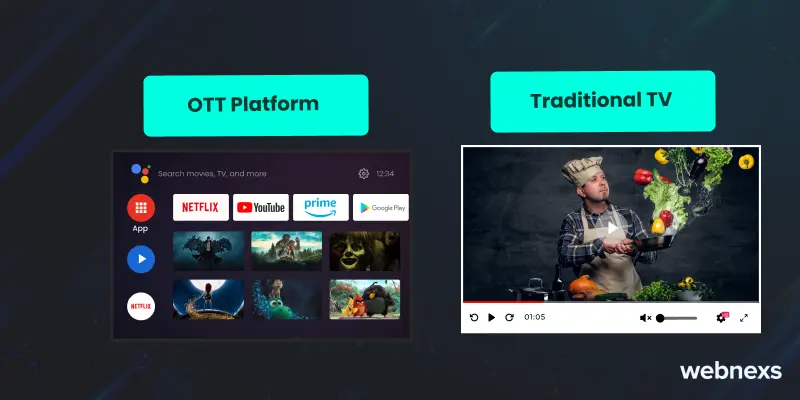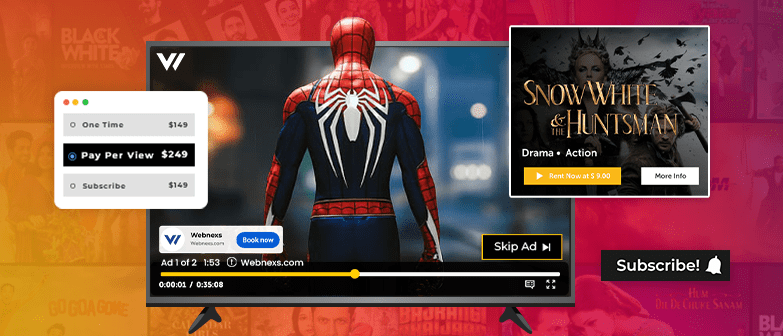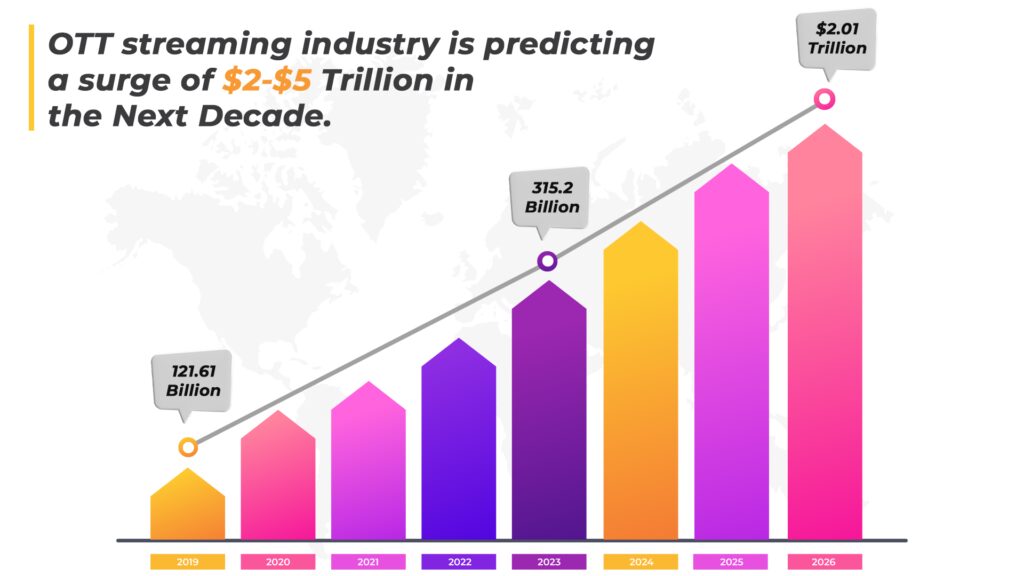Traditional TV is fading—are you noticing it too?
The traditional TV audience has been significantly reduced while shifting to online platforms such as YouTube, Netflix, and Disney+.
Current viewers prefer a more flexible and on-demand approach to their shows, moving away from fixed programming, among other things.
This shift is initiated by OTT platforms that allow people to decide in terms of what, when, and how they watch in order to better suit their preferences.
OTT platforms have not only replaced traditional TV but have also extended their influence to every form of entertainment, such as series and live events, while giving viewers total control.
Statista predicts that the overall global OTT revenue will rise from $123.34 billion in the current year to $343.82 billion by 2025, and by 2029 will have reached $443.29 billion.
OTT is currently the thing for content creators and businesses who want to prosper in the digital era.
With all this information, you might be wondering, what exactly does “OTT” mean? Let’s dive into the OTT full form and understand its significance.
This blog will focus on what is OTT, how it operates, and why it is changing the way people understand the term entertainment.
What is OTT: Full Form and meaning?
OTT full form is Over-the-Top, which refers to the delivery of media content, including live streaming, over the internet, bypassing traditional cable or satellite broadcasting methods.
One distinct element is that content can be consumed anytime across multiple devices as supported by the platform.
A key feature of OTT platforms is their ability to distribute content across geographical borders. Popular examples of OTT platforms include Netflix and Amazon Prime Video for video-on-demand, and YouTube and Twitch for live streams.
What is the importance of OTT in media consumption?
The significance lies in the convenience of accessing entertainment and educational content, and this attributing factor has increased the consumption rate drastically over the years.
Since it started gaining traction in 2010, a whopping 300-500% global OTT consumption growth rate has been recorded till 2023.
Furthermore, research projects the industry to reach approximately $2.8 trillion by 2034. This highlights the shift in trends in content consumption patterns over the years.
Here are some of the distinct features of OTT platforms:
- On-Demand Content: The choice of content for consumption completely lies with the user, giving them greater control over their entertainment preferences.
- Global Reach: OTT technology is not only restricted to breaking geographical barriers but also provides content in multiple languages.
- Increased Control for Content Creators: Greater control over distribution lies with OTT platforms, and this discretion allows them to keep costs under control.
- Personalization: AI-driven content recommendations are offered based on user preferences, creating an engaging user experience.
Key Features of OTT
1. On-Demand Content
- Users can watch movies, TV shows, or videos without time and physical barriers.
- Scheduled broadcasting is not required as the content is available 24/7.
2. Cross-Platform Accessibility
- The platform is accessible on a variety of devices, including smart TVs, desktops, tablets, smartphones, and gaming consoles.
- Device syncing delivers a continued viewing experience.
3. Multiple Monetization Models
- Subscription Video on Demand (SVOD): Revenue is generated from subscriptions at regular intervals.
- Ad-supported Video on Demand (AVOD): Revenue is generated from ad impressions and CPMs.
- Transactional Video on Demand (TVOD): Revenue is generated from renting individual pieces of media content.
- Hybrid models: A combination of the above-mentioned models.
4. Personalized Recommendations
- AI-based algorithms suggest content based on user behavior, watch history, and preferences.
5. Digital Rights Management (DRM) & Security
- Ensures content is protected from piracy.
- Includes watermarking, encryption, and licensing controls.
6. Live Streaming Capability
- Great for events, sports, webinars, or interactive content.
- Includes real-time chat, polls, and audience interaction features.
Technical Overview: How OTT Services Work
Over-the-top (OTT) services refer to those that distribute video content directly to the end-users via the Internet, with the help of adaptive (streaming), content delivery networks (CDNs), and device-compatible (protocols), that can, therefore, let the same video play on different devices without using traditional broadcast methods.
How OTT Streaming Works:
OTT employs internet protocols for content delivery instead of traditional TV broadcasting. Generally, the core of content delivery relies on:
Adaptive Bitrate Streaming (ABR): A technology that automatically adjusts video quality in real time based on the user’s internet speed. It is also responsible for content preloading when the network is robust to guarantee bufferless streaming and thumbnails, and for video resolution downgrade during network slowdown.
Content Delivery Networks (CDNs): Video content distribution across tens of servers in the world. These servers receive a latency reduction when a viewer is served by a server in a location that is near them. Such a situation ensures faster loading and no interruption of the video stream.
Streaming Protocols That Power OTT: HLS (HTTP Live Streaming): An ogoing and analysis-free process that Apple used to develop a protocol that segments the video into chunks, and streams it dynamically. The Multisolution video technology is also compliant with any large or small electronic gadget, irrespective of the type of new CDNs that were utilized.
MPEG-DASH: An open-source, on-demand video streaming technology similar to HLS, that supports codecs in a more versatile way and is also suitable for real-time streaming of multimedia data with a low delay.
Device Compatibility & Encoding:
OTT platforms work on different software and devices. They use codecs like H.264, H.265 (HEVC), and VP9 to compress and encode video, which also makes it stream-friendly and storage-efficient. This feature makes it possible for users to switch between any screen size or any Operating System platform without losing quality.
OTT Platform vs. Traditional TV

One of the biggest differences between OTT platforms and traditional TV is the way it delivered them to consumers.
Traditional TV is delivered through cable, satellite, or broadcast networks, while streaming services deliver content over the internet.
This means that users don’t need to subscribe to a cable or satellite service to access content on an OTT platform.
Another significant distinction lies in the control users have over their viewing experience.
Traditional TV restricts viewers to the programming schedules determined by networks or cable providers.
It offer on-demand access to a wide range of content, allowing users to watch their favorite shows and movies whenever they want.
The term is also applied to online video platforms, as well as audio and video streaming solutions.
Looking To Build Your Own OTT Platform?
Different Types of OTT

There are several different types of OTT platforms, each with its own unique features and target audience. The most prevalent types include:
Subscription Video-on-Demand (SVOD) Platforms: These SVOD platforms offer users access to a large library of content for a monthly subscription fee. Netflix, Amazon Prime Video, and Hulu are prime examples of popular streaming platforms.
Transactional Video-on-Demand (TVOD) Platforms: These TVOD platforms enable users to rent or buy individual content, such as movies or TV shows, on a pay-per-view model. Services like Amazon Instant Video and Google Play are examples.
Ad-Supported Video-on-Demand (AVOD) Platforms: These platforms offer free content to users in exchange for displaying advertisements. Examples include YouTube and Tubi.
Live Streaming Platforms: These platforms allow users to watch live streaming events, such as sports games or concerts, in real-time over the internet. Examples include ESPN+ and Sling TV.
Benefits of OTT Services for Consumers
- On-Demand Accessibility
Consumers can choose to watch at their convenient times and places.
- Cost-Effective Entertainment
Services are offered at affordable rates or even for free in the ad-supported model.
- Diverse Content Choices
Access to a vast content library that includes genres and languages that exceed the services offered by traditional media.
- Multi-Device Streaming
The platform can be accessed from various devices to enable convenience of use.
- Ad-Free Experience
Subscription-based models offer ad-free viewing experience.
Benefits of OTT Services for Providers
- Global Reach
OTT platforms can be accessed via the internet, which overcomes geographic restrictions.
- Low Distribution Cost
Physical infrastructure is not required, rather content distribution can occur over the internet.
- Scalable Business Models
Offers multiple methods of monetization that include SVOD, AVOD, TVOD, freemium and hybrid models.
- Direct-to-Consumer Relationship
Consumer data can be gathered using analytics without relying on intermediaries.
- Rich Analytics
Real-time data on user behavior can be used for optimizing content strategy.
Why Your Business Needs an OTT Platforms
Unleash Your Creativity:
Meaning of OTT offers you complete control over your content, brand, user experience, audience analytics, monetization, and other archive data at the time of launch.
Moreover, you’re not bound by the same rules and regulations as on YouTube.
Ad-Free Empowerment
OTT offers consumers the ultimate freedom to choose what they want to watch and only pay for the subscription service they opt for.
Direct-to-Consumer Approach
If your viewers are curious about what is an OTT full form? and what does OTT mean and how it can benefit them, you can inform them that it is the most effective way to reach your target audience with valuable content.
By offering a premium VOD experience that you fully control, you can boost direct engagement and receive immediate feedback.
Freedom for Your Customers
OTT offers consumers the ultimate freedom to choose what they want to watch and only pay for the services they opt for.
This level of convenience is driving industry uptake, making it more important than ever to have an OTT solution for your business.
Ready to tap into the power of an OTT service? Look no further than Webnexs, a leading video streaming platform offering comprehensive solutions tailored to your business needs.
With Webnexs, you can empower your brand with an OTT solution that puts you in control.
Turn your OTT dream into reality-See how we did it!
How Does OTT Impact the Entertainment Industry
- Decline of Traditional TV and Cable:
Increased cord-cutting has reduced OTT platform viewership and ad revenue for traditional media broadcasters.
- Reduced Dependence on Theaters:
Movie releases are simultaneously or directly released on OTT, reducing the dependence on theaters.
- Global Content Reach:
Viewership has increased due to ease of accessibility as geographical and lingual barriers are removed.
- Shift in Consumer Behavior:
Consumer content preferences have shifted toward binge-worthy, ad-free, and on-demand content for greater convenience.
- Increased Competition:
Competition has been intensified as more OTT providers have entered the industry to gain a significant market share.
Challenges and Solutions Facing OTT the Industry
- High Content Production Costs
Demand for newer content puts pressure on OTT platforms to publish original content that require heavy investment.
Solution:
Invest in data-driven content planning, use co-production deals or licensing or adopt user-generated content or low-budget formats.
- Fierce Competition
The wider audience segment and increasing number of OTT providers make it difficult to amass a huge user base.
Solution:
Focus on niche segments, invest in exclusive content, build strong brand identity, and offer value-added features to lure the users from other OTT providers.
- Subscriber Retention
Churn rates increase when viewers cancel subscriptions after watching individual pieces of content.
Solution:
Consistently update the content library, implement loyalty programs and offer content recommendations using AI to keep the customers engaged.
- Revenue Monetization
Balancing ad fatigue and revenue generation is challenging given the need to satisfy users.
Solution:
Implement hybrid monetization models for diversified revenue generation, offer pricing plans and use dynamic ad insertion for relevant and less intrusive ads.
- Bandwidth and Infrastructure Issues
Regions lacking internet infrastructure cannot be penetrated to provide quality service.
Solution:
Use adaptive bitrate streaming, allow offline downloads, and partner with CDNs and edge servers for efficient content delivery.
The Future of OTT Services

As the OTT market continues to grow, there are several key trends that are shaping the future of the industry.
One trend is the increase in original programming produced by OTT platforms. Platforms such as Netflix, Amazon Prime Video, and Hulu have all invested heavily in original programming, and this trend is expected to continue as platforms look to differentiate themselves from their competitors.
Another trend is the rise of niche OTT platforms targeting specific demographics or genres.
For example, Shudder is a streaming service that specializes in horror movies and TV shows, while Crunchyroll is a platform that offers anime and manga content.
As the OTT market becomes more crowded, niche platforms may carve out a space for themselves by offering specialized content that isn’t available on more general platforms.
Finally, integrating OTT platforms with other devices and services is expected to continue.
For example, many smart TVs now come pre-installed with OTT apps, and some cable providers are now offering their own OTT platforms besides traditional TV services.
As more and more devices become connected to the internet, the potential for OTT platforms to reach new audiences will only increase.
Who’s Leading the OTT Revolution in 2025?
The OTT (Over-the-Top) industry, as the digital media further consolidates its control on the industry, is witnessing a massive surge in demand that was not seen before. By 2025, the world’s foremost platforms, as well as the new entrants, are reshaping the way people consume content both domestically and internationally.
Global OTT Leaders in 2025
Netflix: Netflix is keeping ahead of everyone. Netflix is still leading the chart with its huge investment in original content and the proliferation of regional programming. The company’s extensive presence across markets and its AI-driven personalization is not to be questioned yet. Through such initiatives, Netflix has continued to be the leader of innovation in the streaming industry.
Amazon Prime Video: A behemoth in transactional and subscription methods, Amazon not only has an array of content to pick from but also possesses a significant role in sports rights and an entwined e-commerce ecosystem that is unparalleled in terms of user experience.
Disney+: Disney+ has joined together the popular products with the great franchises (Marvel, Pixar, Star Wars), expanded to 100+ countries, and the cooperation with Hulu and ESPN+ has not only sustained but increased its power on the market.
HBO Max: After entering more regions, HBO Max has emerged as the leading platform that offers award-winning original content and Warner Bros movies, providing moviegoers with a very exciting experience, creating an exciting experience that builds subscriber loyalty.
YouTube: Even to this day, YouTube continues to be an unparalleled platform that reaches out to the most far-flung areas, hence having a library from the viewer-created content to live shows, premium films, and tutorials. In addition, YouTube TV is on the up and up as a live streaming alternative.
Regional OTT Leaders Gaining Momentum
Zee5 (India): Zee5, in the Indian market, is not only the champion of the multilingual medium, but also they are successfully offer exclusive content to their audience, and they continue to do so by being present in South Asia and the Middle East.
iQIYI (China): iQIYI is the leading OTP in China that is growing its business internationally and providing drama, animation, and a variety of shows, all with subtitles in different languages.
Stan (Australia): By holding the rights exclusively to the premium U.S. content, such as Showtime, Starz, Universal, only Stan can be called the king of the Australian OTT market.
Fast-Emerging Niche Platforms in 2025
Crunchyroll: After Sony acquired it, it is on its way to becoming the biggest anime streaming platform, attracting anime fans across the globe.
MUBI: The finest in “film of the best kind” is a term I mostly hear about MUBI, where classic and festival movies are especially selected for cinema lovers who wish to have an alternative to popular world content.
CuriosityStream: Education and edutainment no longer require a teacher or educator to be accessible, as the documentaries highlighted by the platform speak directly to the interests of these groups and cover science, tech, and history adequately.
What Are the Key Differentiators of These Platforms?
Content Originality: Not only is the master brain behind the likes of Netflix, Disney+, and HBO Max the main supporter of the original content, but they also invest heavily in each show to ensure top-quality productionLocalization: Global brands like Zee5 and iQIYI keep with foreign language preferences and cultural suitability to engage local audiences.
Monetization Models: Changing from SVOD, TVOD, to AVOD and the combination of models, lead platforms can acquire different income sources.
Device Accessibility: Brands that offer accessibility on all possible platforms make sure that users can easily switch between the streaming devices they like.
Real-World Success: How OTT business reach 80k subscribers using Webnexs
OTT platforms are transforming the way businesses reach their audience. One great example is SAKA Chhimbal, which successfully launched its OTT streaming service with Webnexs.
The Challenge
SAKA wanted to build a feature-rich OTT platform to deliver high-quality video content to its users. The goal was to ensure a seamless streaming experience while maintaining flexibility for future growth.
The Solution
Webnexs provided SAKA with a custom-built OTT platform, offering:
Smooth and secure video streaming
Scalability to support user growth
Optimized performance for different devices
The Result
30% increase in user engagement after launching the platform
100+ new subscribers in a short period
Improved streaming quality and user experience, helping SAKA scale efficiently
If you’re looking to launch a powerful OTT platform like SAKA Chhimbal, Webnexs can help!
👉 Read the full case study here!
Want to Build Your Own OTT Platform with Webnexs?
Webnexs is a leading OTT platform that helps creators, broadcasters, and businesses build their own video streaming apps or websites without needing to code.
It supports all devices like phones, smart TVs, and laptops, and lets you earn through subscriptions, ads, or pay-per-view. You can fully customize the platform to match your brand.
With features like smooth streaming, strong security, and real-time viewer stats, Webnexs makes it easy to grow your streaming business.
OTT Features on Webnexs
Webnexs provides a robust OTT platform that is adaptable and user-friendly. It helps the creators, broadcasters, and industries deliver uninterrupted video streams. The innovative features that set Webnexs apart as an OTT industry leader are as follows:
Multi-Screen Support:
Share your video across all devices, such as smart TVs, smartphones, tablets, laptops, etc. Webnexs guarantees its acquaintance with Android, iOS, Roku, Fire TV, and Apple TV.
VOD & Live Streaming:
Host both on-demand videos and live broadcasts. Whether it’s a video library or a sports play-by-play coverage, Webnexs can be used for both with excellent reliability.
Adaptive Bitrate Streaming (ABR)
Get picture-quality with ABR innovation that scales the video’s resolution according to the user’s internet speed.
Global CDN Integration
The updated Content Delivery Networks can provide users worldwide with further accelerated and high-speed stream delivery. The better optimized CDN reduces latency and guarantees consistent video quality.
DRM & Security
The powerful digital copyright protection and legal options include Digital Rights Management (DRM), royalty stamps, geo-blocking, and safe login features.
Multiple Monetization
Models Moreover, one can opt to earn revenue on the Subscription (Subscription), Pay-per-view (TVOD), Ad-based (AVOD), or the hybrid model—Webnexs gets through all OTT revenue models.
Advanced Analytics
In-depth analytics, for example, will help you know about viewer engagement, watch time, the highest quit point of the program, etc. All these analytics can be used as a source of information to make more informed decisions.
White-Label Solution
Webnexs is the best choice for you if you want to launch a branded OTT app or site. The Webnexs platform facilitates retirement of the off-the-shelf solution, which is fully customizable and white-label-ready.
Now that you know the OTT full form, it’s time to turn your OTT platform idea into reality.
Conclusion
OTT platforms have revolutionized the way we consume video content, offering on-demand access to a wider range of programming than traditional television.
As the industry continues to evolve, we can expect to see continued innovation in terms of content production, distribution, and business models.
Whether you’re a fan of classic movies, niche programming, or the latest hit TV shows, there’s an OTT platform out there for you.
OTT platforms have also allowed for more diverse voices to be heard, with independent filmmakers and content creators now able to reach a wider audience without having to go through traditional gatekeepers.
This democratization of content creation and distribution is one of the most significant impacts of the OTT revolution.




29 Responses
Hello,
I am currently searching for a solution for an OTT platform and its meaning. OTT stands for Over-The-Top, which refers to delivering digital content over the internet. Our primary aim is to provide our audience with free content while simultaneously earning revenue through AVOD. I am interested in knowing more about how Webnexs operates and whether it can offer us the tools we need to achieve our goals. Please provide me with more information so that we can have a detailed discussion about the potential opportunities.
The article provides a helpful breakdown of the different types of OTT platforms, including subscription-based services like Netflix and Amazon Prime Video, ad-supported services like Hulu, and transactional services like iTunes and Google Play. By explaining the differences between these platforms and incorporating the OTT definition, the article helps readers understand the different business models and revenue streams used by content providers.
Overall, the blog post on understanding OTT platforms provides a great introduction to the topic, including the full form OTT, and I would recommend it to anyone who is interested in learning more about this exciting area of the entertainment industry.
Despite these potential downsides, it is clear that OTT platforms are here to stay and will continue to play a significant role in the entertainment industry. OTT means full form Over-The-Top, referring to content delivery over the internet. As technology continues to evolve, it will be interesting to see how these platforms evolve and what new innovations they will bring to the table.
For example, the abundance of content available on OTT streaming services can sometimes be overwhelming for consumers. With so many options, it can be difficult to decide what to watch, and viewers may end up spending more time browsing than actually watching. Additionally, the rise of OTT streaming platforms has led to a decline in traditional TV providers, which has had an impact on the jobs of people working in the industry.
That’s a good point. While the article does a great job of highlighting what is ott?and advantages of OTT platforms, it would also be useful to discuss some of the potential drawbacks.
Overall, the blog post offers a great overview of vod platforms, their benefits, and their impact on the entertainment industry. It is a helpful resource for those who are interested in this topic and want to learn more. The only suggestion I would have is to include some information about the potential downsides of vod platforms, such as the potential for content overload and the impact on traditional TV providers
I am looking for a way to share free content with my audience and earn revenue through Ads on an ott platform. Can webnexs help me with this? I would love to hear from you to discuss the possibilities.
The article also touches on the importance of user experience in the success of vod platforms. With so many options available to consumers, the user interface and ease of navigation can be a crucial factor in determining which platform they choose to use. The article provides examples of some of the most user-friendly ott platforms, such as Netflix and Hulu.
In addition, the article provides insights into the meaning of vod platforms for content providers. One of the key benefits is that they offer a more cost-effective way of distributing content compared to traditional TV services. The ability to bypass cable and satellite providers and go directly to consumers via the internet allows content creators to reach a wider audience and potentially earn more revenue.
Overall, I found the blog post to be a great introduction to the world of OTT . It is written in a clear and concise manner, making it easy to understand for readers who may not be familiar with the topic. I would recommend this post to anyone who wants to learn more about OTT and how they are changing the entertainment industry
One thing that stood out to me is the discussion of how OTT platforms are disrupting the traditional TV industry. The article highlights how these platforms have changed the way people consume content and how they have created new opportunities for content creators and producers
The blog post on understanding OTT full form is quite informative and well-written. It provides a comprehensive definition of OTT and explains how they differ from traditional cable and satellite TV services. The article also goes on to list some of the most popular OTT platform providers and the type of content they offer, which is useful for readers who are new to this concept.
Hi there, I’m in search of a solution for an OTT platform. I’m interested in knowing the meaning of OTT, can webnexs assist us in achieving this? I strongly believe that working together could lead to great results. Let’s connect to discuss the possibilities.
Overall, the article is a great resource for anyone looking to better understand OTT full form. By providing clear explanations and relevant examples, the article helps readers understand the impact of OTT on the entertainment industry, as well as the advantages and potential drawbacks of using these platforms.
One area where the article could be improved is by providing more information on how digital entertainment platforms are changing the entertainment industry as a whole. For example, are traditional TV broadcasters feeling pressure to adapt to the rise of digital entertainment platforms? Are we seeing a shift in the types of content being produced as a result of digital entertainment platforms? These are interesting questions that could be explored further.
One potential downside of streaming services is the fact that they require a reliable and fast internet connection. This can be a challenge for people living in areas with poor internet infrastructure or for those who cannot afford high-speed internet. Additionally, some content providers may choose to remove their content from streaming services in favor of exclusive deals with traditional TV broadcasters, limiting the amount of content available on streaming services.
Hey there! I’ve been hunting for a solution for an OTT platform ? Our aim is to provide our audience with video content while earning revenue through PPV. I’m curious, can webnexs help us with this? Let’s connect and chat about the potential opportunities
The article does a great job of explaining the advantages of using streaming services. By offering a wider variety of content, personalized recommendations, and the ability to watch shows and movies on demand, streaming services have changed the way we consume entertainment. Additionally, the ability to access these platforms on a variety of devices, such as smartphones and smart TVs, has made it easier than ever to watch our favorite shows and movies wherever and whenever we want.
Great post! ?Very well explained and informative about what is ott and OTT full form and meaning. Keep up the good work! ?
I love how OTT streaming services are changing the way we consume content. It’s amazing how we can now access all our favorite shows and movies on-demand. Thanks for sharing!
I had no idea on ott full form until now. Thanks for sharing this informative post. I’m curious to know if you have any recommendations for must-watch shows on OTT platforms?
Looking for a solution for video on demand platform & meaning of ott. Can webnexs offer vod services? Let’s discuss possibilities.
Greetings! I’m searching for a solution for an OTT service and its meaning. Our focus is on delivering free content to our audience while generating revenue through advertisements. Can webnexs help us achieve this? I would love to hear from you so we can explore the possibilities.
Hey! Want to stay in the know about the latest trends? It’s the perfect time to learn about what is OTT ? and full form of ott platforms.
It is helpful to be knowledgeable about current trends, and now is the opportune moment to familiarize oneself with the concept and meaning of vod platform.
Such a great guide on what is OTT! The explanation is super clear and easy to follow. I feel like I have a much better grasp of OTT now, and I’m definitely sharing this with my friends who are curious about it.
A perfect guide to understanding what is OTT! The explanations are clear and concise. Thanks for sharing this insightful content! I now feel much more confident in discussing OTT with others. The examples provided made everything so much easier to grasp, and I can’t wait to share this with my colleagues.
Great read! This blog clearly explains what is OTT and its significance in today’s entertainment industry. Highly informative!